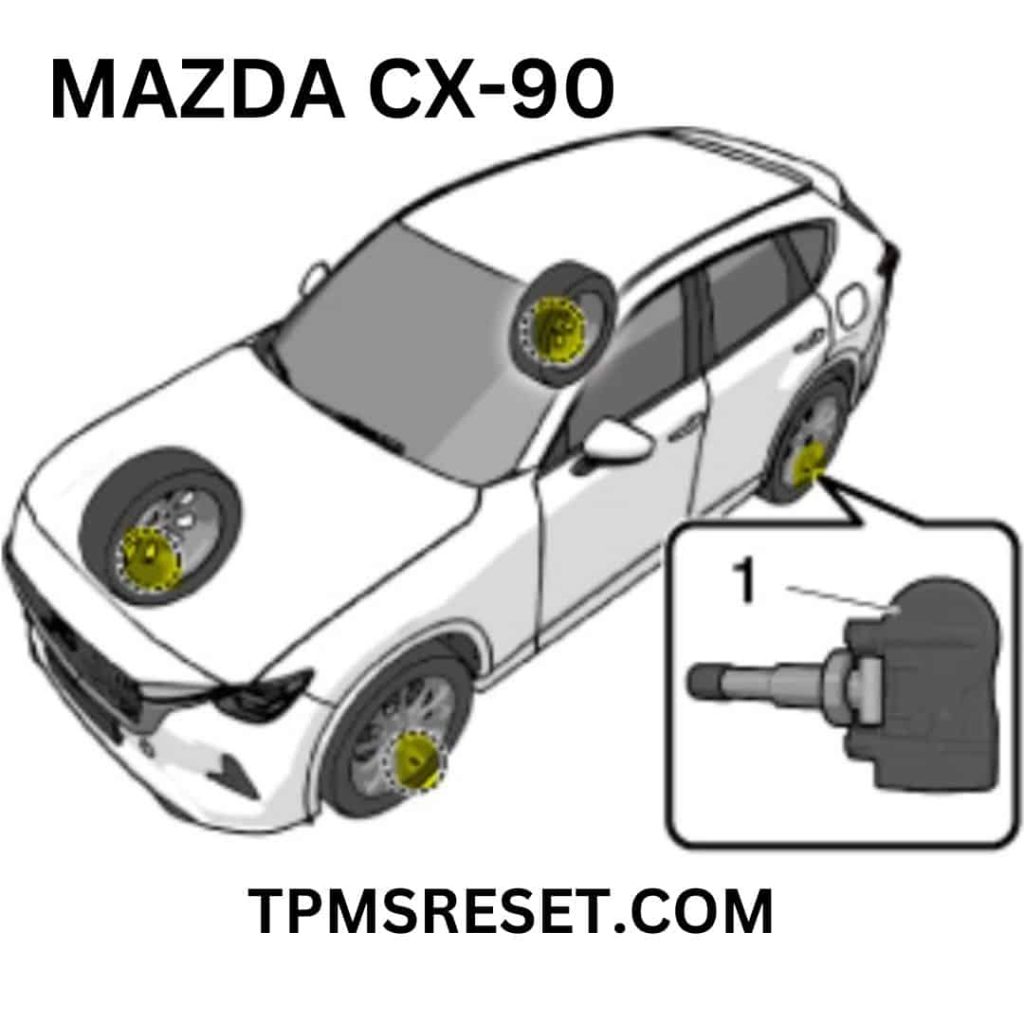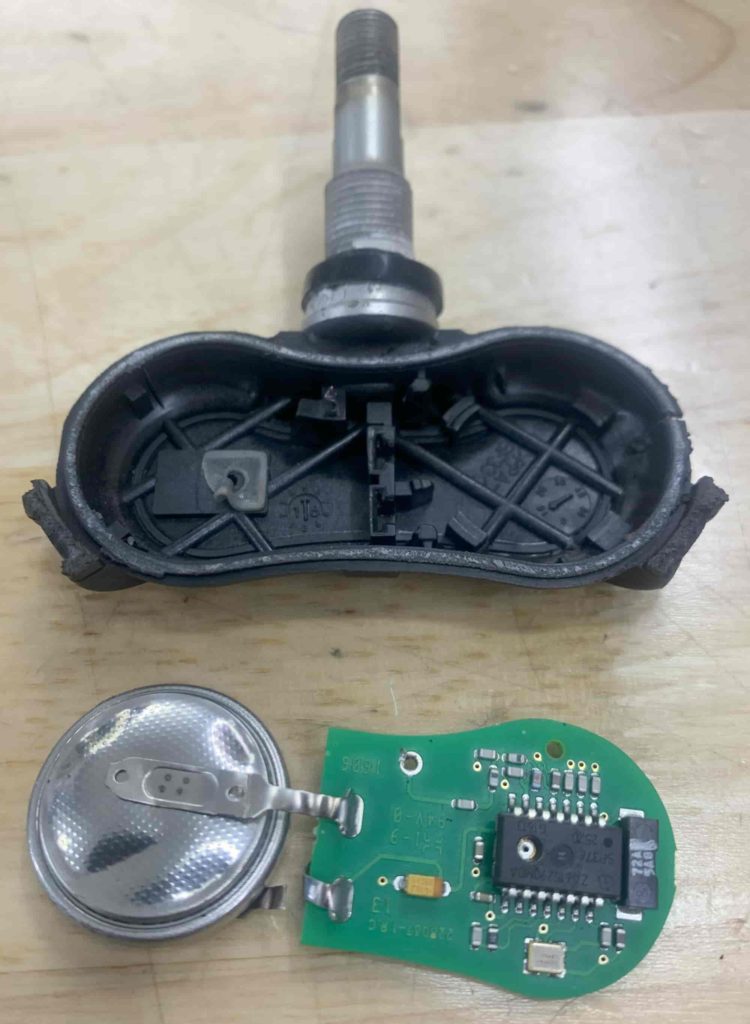How Mazda CX-90 TPMS Works
Pressure Sensors in Tires: Each tire has its own pressure sensor that continuously checks the air pressure inside the tire.
Data Transfer: These sensors send real-time tire pressure information wirelessly to the Mazda CX-90’s onboard computer system.
Sensor Battery Life: Pressure sensors are battery powered and usually last about 5-10 years.
Vehicle Startup: When the car starts, the TPMS automatically activates and starts collecting data from the tire pressure sensors.
Continuous monitoring: The system constantly checks tire pressure, making sure it stays within the recommended limits.
Warning thresholds: The TPMS has predefined pressure limits for each tire, based on Mazda’s guidelines.
Pressure Changes: If tire pressure goes beyond the established thresholds (either too high or too low), the TPMS sets off a warning.
Warning light activation: If there’s an issue with tire pressure, the TPMS lights up a warning signal (yellow exclamation point) on the dashboard to notify the driver.
Error codes: Besides the warning light, the TPMS may also give error codes or specific details about which tire has pressure problems if scanned with a TPMS diagnostic tool.
Steps to Reset Mazda CX-90 Tire Pressure Light
Step 1: Check and Adjust the Tire Pressure
The 2024 Mazda CX-90 does not have a tire pressure reset button so it’s important to know how to turn off the tire pressure warning light. Start by setting all 4 tires to exactly 36 Psi. Remember to adjust the tire pressure only when the tires are cold. (this means before driving long distances or after the car has been parked for a few hours)
Step 2: Drive the Mazda CX-90
After setting your front and rear tire pressures to 36 Psi, drive the car. Mazda says you need to drive the car for at least 3 minutes at speeds of at least 16 Mph. After driving the vehicle, the tire pressure light will go off. If the light doesn’t go out right away, keep driving.
Step : Re-Check Tire Pressure
Double check your tire pressure after the tire pressure light has turned off.
Tire Pressure
How Weather Affects Tire Pressure
The chart above illustrates the relationship between air temperature and tire pressure changes in both Fahrenheit and Celsius, as well as PSI and kPa units. It proves that as the air temperature decreases, tire pressure drops accordingly, while the opposite occurs when the temperature increases. The baseline temperature for checking tire pressure is considered to be around 62°F (16.7°C), where no real tire pressure changes will occur. Basically, for every 10 degree drop in air temperature, tire pressure will decrease by about 1 PSI.
How to Check Tire Pressure
Locate the correct tire pressure information: This information can be found on the driver side door jamb on a white sticker.
Get a tire pressure gauge: These can be purchased from any auto parts store or Amazon.
Wait for the tires to cool down: Tires heat up when you drive, and heat can increase tire pressure. It’s recommended that you check the tire pressure when the tires are ‘cold’ or haven’t been driven on for at least three hours.
Remove the valve cap on the first tire: The valve cap is the small cap that you see on the tire valve stem. It’s where you can inflate the tires with air.
Attach the tire pressure gauge: Put the pressure gauge onto the valve stem and press down quickly to get a reading. The gauge will pop out and show a measured number or show a reading on the display.
Check the reading: This is the pressure of your tire. If the number matches what’s recommended on the sticker you’re good to go. If it’s lower than the recommended psi (pounds per square inch), you’ll need to inflate your tire.
Inflate the tire if necessary: If the tire pressure is too low, inflate the tire using an air compressor. Attach the air hose to the valve stem and add air in short bursts, checking the pressure frequently until it reaches the recommended level.
Replace the valve cap: Don’t forget to put the valve cap back on the tire. This protects the valve stem from getting clogged with dirt and debris.
Repeat for all tires: Follow the same process for all the tires on your vehicle. Don’t forget to check your spare tire as well.
2024 Mazda CX-90 Tire Pressure
TIRE SIZE | FRONT PSI | REAR PSI |
255/60R18 | 36 | 36 |
265/55R19 | 36 | 36 |
275/45R21 | 36 | 36 |
SPARE | 60 | 60 |
Impacts of Driving With Underinflated Tires
Underinflated tires can have several impacts on your Mazda CX-90’s driving experience and your vehicle’s health:
Decreased fuel efficiency: Underinflated tires have a larger contact area with the road, which means more friction. This results in higher fuel consumption.
Increased tire wear: Because underinflated tires have more surface area in contact with the road, the edges of the tire tread wears out more quickly.
Poor handling and reduced stability: Underinflated tires can affect your vehicle’s handling and make it feel sluggish or unresponsive, particularly in corners.
Increased risk of tire damage: Underinflated tires are more susceptible to damage like punctures and blowouts, as they’re less able to absorb impacts from potholes or debris.
Longer stopping distances: If your tires are underinflated your CX-90 may take longer to stop when you apply the brakes, especially in wet conditions.
Reduced load carrying capacity: A tire’s ability to carry load decreases when it’s underinflated, which can be particularly problematic when the CX-90 is heavily loaded.
Increased risk of tire failure: Severe underinflation can cause tires to overheat, leading to tire failure. This can be dangerous at high speeds.
Decreased lifespan of the tire: Underinflation can lead to premature tire aging and can reduce the overall lifespan of the tire.
Tire Pressure Light
What Causes the Tire Pressure Light to Come on?
Spare Tire: If you’re driving with a donut or non-full sized spare tire on the Mazda CX-90, it will trigger the tire light to turn on.
Seasonal Weather temperature changes: An air temperature decrease will cause tire pressure to decrease, causing the tire light to come on.
Tire puncture or leak: Screws and nails scattered on the road can penetrate the tire’s tread, leading to a loss of air pressure.
Faulty TPMS sensor: Damaged or malfunctioning tire pressure sensors can cause the tire pressure light to flash or not give accurate readings.
Tire damage: Encountering potholes or hitting curbs while driving can result in structural harm like tire bulges and bubbles in the tire sidewall, which can subsequently lead to a decrease in tire pressure.
Sensor battery life: Tire pressure sensors operate on battery power and will ultimately deplete after a period of time.
Recent tire rotation or replacement: Following a tire rotation or replacement, the tire pressure monitoring system may require recalibration to avoid inaccurate tire location indicators and alerts.
Valve stem issues: A compromised or leaking valve stem can lead to a loss of tire pressure, which will trigger the air pressure warning light. The rubber gasket that sits between the sensor base and the valve stem can succumb to dry rot, losing its sealing capacity and allowing air to escape. (it can be replaced without having to replace the entire sensor)
Wheel or rim issues: Wheels that are cracked, damaged, or corroded can result in air leakage and a decrease in tire pressure. This is particularly prevalent with low-profile tires, as they provide less safeguarding to the wheel itself.
Altitude changes: When there is a change in altitude, air pressure can change and sometimes set off the low tire pressure light.
Natural pressure loss: One of the most detrimental things you can do to your Mazda CX-90’s tires is to leave them stationary for extended durations (weeks/months/years). Due to temperature fluctuations and permeation, tires gradually lose air pressure when they sit for long periods of time. Tires that remain idle can develop dry rot necessitating their replacement.
TPMS Software Updates: Occasionally the tire pressure system may have a software update from Mazda.
Is it Safe to Drive With the Tire Light On?
Determining the cause of the tire light activation in your Mazda CX-90 is crucial in assessing whether it’s safe to continue driving with the light on. Is there a puncture in the tire, such as from a nail? Is the tire losing air? Is the air escaping slowly or quickly? Are the tires in good condition, but the sensors malfunctioning? Although in some cases it might be safe to drive with the tire light on, in other scenarios it could be hazardous. Recognizing the underlying issue is essential for deciding whether it’s safe to continue driving your Mazda CX-90 and for what duration.
Mazda CX-90 TPMS Malfunction Indicator
Your Mazda CX-90 has a TPMS malfunction indicator that alerts you when the tire pressure system isn’t working properly. This indicator uses the same dashboard tire light as the low tire pressure alert, but it has a different function. If the tire pressure monitoring system has an issue, the warning light will flash for around one minute before staying lit continuously. This pattern will keep happening every time you start the car until the problem is fixed. Keep in mind that when the indicator is on, the system might not be working correctly.
Tire Pressure Sensor Batteries
Every tire pressure sensor functions on a standalone integrated battery, similar to those found in conventional wristwatches. It’s important to note that these batteries cannot be replaced as they’re embedded within the sensor’s circuit board. As a result, if the battery depletes or is nearing exhaustion the entire sensor must be replaced. The lifespan of the battery can fluctuate based on elements like driving conditions and weather variations. Typically these sensor batteries have a durability spanning between 5 to 10 years.
Troubleshooting the Tire Pressure Light
If your tire light is on, there are four simple things you can try to get the tire light to turn off.
Is the Tire Losing Air?
Recheck your tire pressure. Confirm that the pressure is still at exactly 36 Psi. If it’s not, you likely have a leak or some sort of puncture. If the tire light goes off after inflating the tires and then comes back on, you definitely have a tire leak.
Wake Up a Sleeping Pressure Sensor
If you have confirmed that none of your CX-90 tires are losing air, yet your tire pressure light remains on, you can attempt to “wake up” the sensor that’s causing the tire light to come on. To do this you can release about 10 or 15 Psi of air from the problem tire, then overfill the tire by about 10 Psi. (To be clear, release air so the tire is measuring at about 15-20 Psi, then add air so the tire measures at about 45 Psi.) Next, drive the CX-90 for a few minutes with the tire overfilled and the tire light will turn off. After 10-15 minutes, be sure to readjust the tire back to the recommended 36 Psi.
Reset the Mazda CX-90 Computer
If all other remedies have been exhausted and your tires aren’t leaking, you can manually erase the diagnostic trouble codes from your Mazda CX-90 electronic control unit (ECU). This can be achieved by detaching the negative terminal of the main 12-volt battery (this applies to hybrid CX-90 models too, as they also have a 12-volt battery). After leaving it for a few minutes, reattach the terminal. This action will erase all fault codes from the ECU, including the tire pressure error code that triggers the tire pressure warning light. If you follow this procedure and the tire light turns off and then reactivates, it’s likely that a sensor is malfunctioning.
Check the Battery Status of Each Tire Pressure Sensor
To run this diagnostic procedure you will need a TPMS programming/relearning tool. Each TPMS tool is a little bit different but this procedure is usually the same. You will scan each pressure sensor by placing the TPMS tool directly next to the tire valve stem and select a “test” button. After scanning all 4 pressure sensors the tool will give you a result on the status of each sensor including battery life.
Tire Leaks and Solutions
How to Find a Tire Leak
To identify a tire leak in your Mazda CX-90, start by checking the air pressure in all four tires to identify the underinflated one. Pump some air into the underinflated tire since finding a leak in a completely deflated tire can be challenging. Next, prepare a mixture of soap and water in a spray bottle (or use a pre-made solution like Windex) and spray it liberally over the entire tire. (Ensure to douse the valve stem and bead seal thoroughly, and make sure the whole tire is sufficiently wet.) Inspect the tire for any small bubbles. If there’s a leak the escaping air will form tiny bubbles at the leakage point. Finding these bubbles might require some patience. If the tire is losing air, it has a leak, so continue spraying and persist with your search!
Are Tire Plugs Safe?
Certainly! Based on my extensive experience with tire plugs during my tenure at tire shops, I can attest to their reliability. They’re excellent at mending punctures in the tread of tires, creating a seal that prevents air from leaking. (Remember to extract the object that created the puncture.) Tire plugs are crafted from robust rubbery materials capable of enduring variations in the tire’s internal air pressure and temperature. If correctly installed, a tire plug can last for the tire’s entire lifespan. It’s important to note that tire plugs aren’t suitable for repairing damage to the tire’s sidewall.
Are Tire Sealants Safe?
Tire sealants should only be used in emergency, last resort situations. When you inject tire sealants into the tire valve stem you are essentially pushing a liquid into the tire. This can cause damage to the tire pressure sensor as well as cause the tire to no longer be balanced. If you do use a tire sealant we recommend taking your Mazda directly to a tire shop and let them know that you have used the tire sealant.
What Tools Should You Keep in Your Car For Emergency Situations?
There are a number of tools we recommend keeping in your Mazda CX-90 for emergency tire situations. These include:
impact gun
19mm or 21mm socket for lug nuts
Tire plugs and tire plug kit
Pliers
Tire pressure gauge
Extra valve caps.
Is it Legally Mandatory to Have TPMS Sensors?
In numerous regions such as the United States and Europe it’s a legal requirement for vehicles to be equipped with tire pressure monitoring system (TPMS) sensors. The TREAD Act, enacted in the U.S. in 2000, requires all vehicles produced after September 2007 to have a TPMS. This law is mainly directed at vehicle manufacturers and is designed to improve road safety by alerting drivers to significant tire pressure changes. European regulations have stipulated since November 2012 that all new passenger vehicles must be fitted with a TPMS. These rules are intended to reduce the incidence of accidents caused by tire-related issues.
Everything in this article is applicable to all 2024 Mazda CX-90 models and trims including the Mazda CX-90 3.3 Turbo Select, Preferred, Plus, Premium, Premium Plus, Turbo S, Turbo S Premium, Turbo S Premium Plus, and Mazda CX-90 PHEV Hybrid.
Please note that this blog post contains Amazon affiliate links. This means that if you make a purchase through one of these links, we at TPMSRESET.com may earn a small commission at no extra cost to you. We only recommend products that we personally use and believe in. Thank you for supporting us.




